How to Get Paid to Test Apps and Games: A Practical Guide for Beginners
If you’re the kind of person who loves discovering new apps or can spend hours immersed in a game, here’s some exciting news: you can actually get paid for it. And no, this isn’t one of those too-good-to-be-true schemes where you end up paying to “join.” This is a real side hustle that combines your curiosity for technology with a genuine need in the industry.
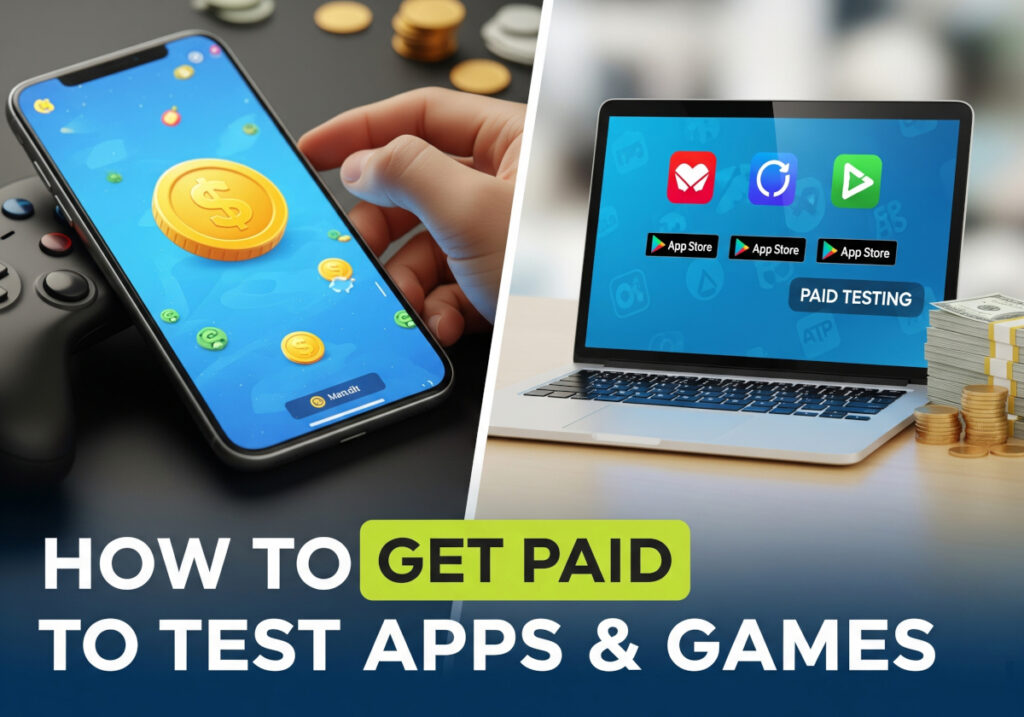
App and game developers are constantly creating new products, and before these products hit the market, they need to know if they work well, look good, and are enjoyable to use. That’s where testers come in. By trying out these apps or games and sharing your honest feedback, you help developers improve their product — and you get paid in the process.
Whether you’re a student looking for extra cash, a stay-at-home parent wanting a flexible gig, or just someone searching for a fun side hustle, this guide will walk you through exactly how to get started.
What Does App and Game Testing Really Mean?
A lot of people think app and game testing is just “playing around” and giving a thumbs-up or thumbs-down. But the reality is more structured and important. In the development world, this is known as Quality Assurance (QA).
When you’re testing, you’re essentially hunting for anything that could go wrong — bugs, glitches, confusing layouts, crashes, slow loading screens, and more. You’re the person who spots these issues before the product gets into the hands of paying users. Think of yourself as part detective, part critic, and part storyteller. You find the problems, explain them clearly, and sometimes even suggest ways to make things better.
Different Kinds of Testing You Might Do
Not every testing job is the same. Depending on the platform or company you work with, you might be asked to do one or more of the following:
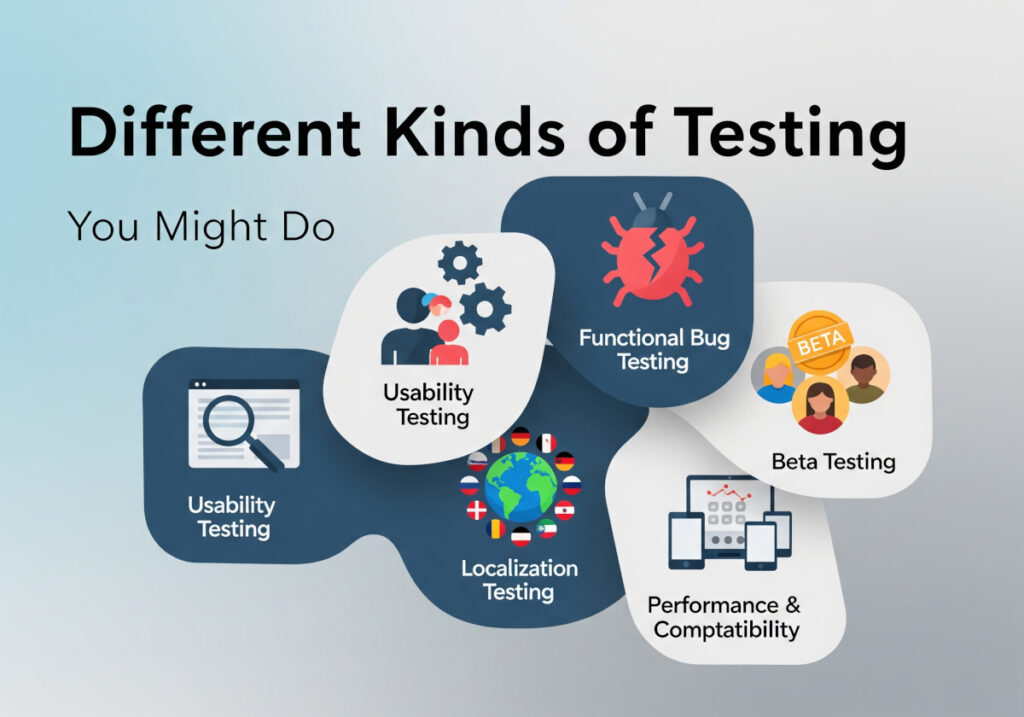
Usability Testing
This focuses on the user experience. Is the app easy to navigate? Do buttons and menus feel intuitive? If you were a first-time user, could you figure out how everything works without getting frustrated? Here, you’ll often be asked to talk out loud while using the product so developers can hear your thought process in real time.
Functional Bug Testing
This is where you actively look for things that are broken — crashes, features that don’t work as expected, incorrect pop-ups, or missing elements. Sometimes you’ll be rewarded per bug found, which can be very lucrative if you’re detail-oriented.
Beta Testing
In beta testing, you try a pre-release version of an app or game. This is the last stage before the public launch, so your job is to find any remaining issues and confirm that everything runs smoothly.
Localization Testing
If a company wants to release their product in different languages or countries, they need to make sure it’s adapted correctly. You’ll check for proper translations, cultural sensitivity, and functionality in that specific region.
Performance and Compatibility Testing
This involves testing the app or game under different conditions — slow internet, low battery, different devices, various operating systems — to make sure it works for all types of users.
Professional QA vs. User Testing
There’s a difference between professional QA roles and user testing panels. Professional QA often requires formal training, experience, and sometimes certifications. These are usually full-time jobs with gaming studios or tech companies.
On the other hand, user testing panels are much more beginner-friendly. You don’t need a tech degree; you just need to follow instructions carefully, give clear feedback, and have access to the required devices. Most of the opportunities we’ll discuss in this guide fall into this category.
The Skills You Need to Succeed: Becoming a Tester
While you don’t have to be a software engineer to test apps and games, you do need certain skills and habits to be effective (and get invited back for more tests).
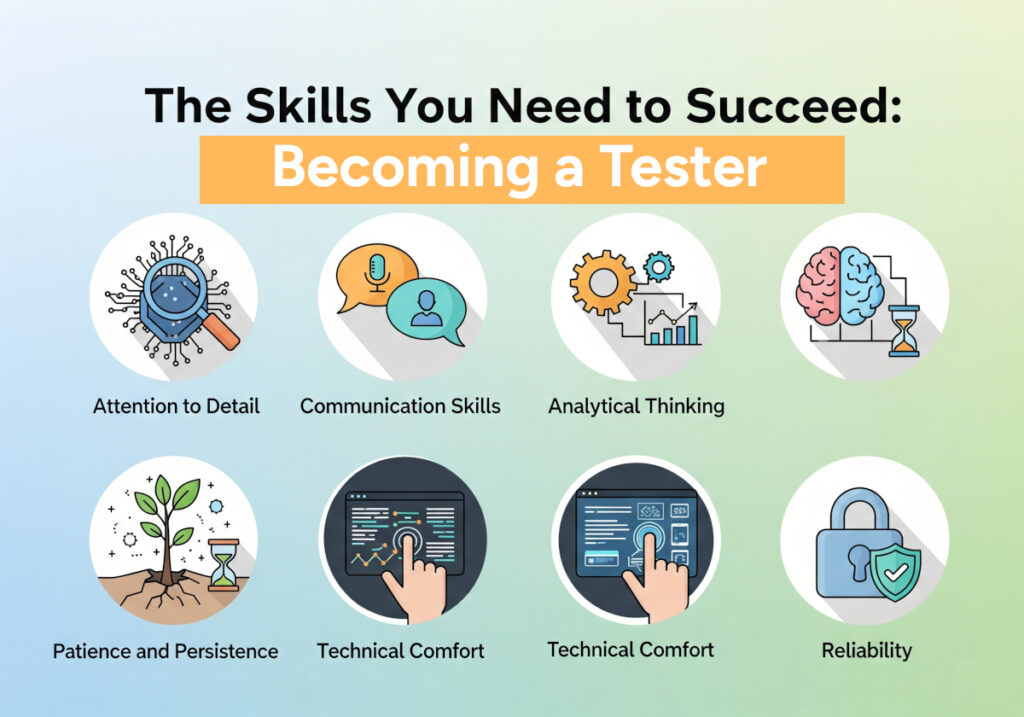
Attention to Detail
You’ll need to spot small inconsistencies others might miss — a button that’s slightly misaligned, a typo in the instructions, or a character in a game that moves awkwardly.
Communication Skills
Being able to clearly explain what’s wrong is crucial. Developers can’t fix a bug if your feedback is vague. Instead of saying “The app froze,” you might write, “The app froze after I clicked the ‘Submit’ button on the payment screen while using Wi-Fi on an iPhone 14 running iOS 17.3.”
Analytical Thinking
Sometimes a bug isn’t just about “what” happened but why it happened. If you can figure out the steps to reproduce an issue, you’ll be more valuable as a tester.
Patience and Persistence
Testing can get repetitive, especially if you’re checking the same feature over and over to see if a bug still exists.
Technical Comfort
You’ll need to be okay with installing apps, adjusting settings, using screen recording tools, and occasionally taking screenshots.
Reliability
If a company gives you 48 hours to complete a test, they expect you to deliver on time — and at a consistent level of quality.
Mindset Matters Too
The best testers have a mix of curiosity, objectivity, and adaptability. You should constantly be asking “What if I try this?” without letting personal preferences bias your feedback. And since each test may come with new instructions, platforms, or devices, you need to adapt quickly.

A passion for apps and games helps — you’ll be more engaged and more likely to give detailed, thoughtful feedback if you genuinely enjoy exploring new software.
Bonus Skills That Can Set You Apart
While they’re not required for beginner-level user testing, knowing your way around bug-tracking tools like Jira or Bugzilla can make you stand out. A basic understanding of how games or apps are developed also helps you anticipate where problems might occur.
Where to Actually Find Paid App and Game Testing Jobs
If you’ve got the skills and mindset down, the next question is: where do you actually get these gigs? Luckily, there are several trusted platforms and methods that connect you directly with companies willing to pay for your feedback.
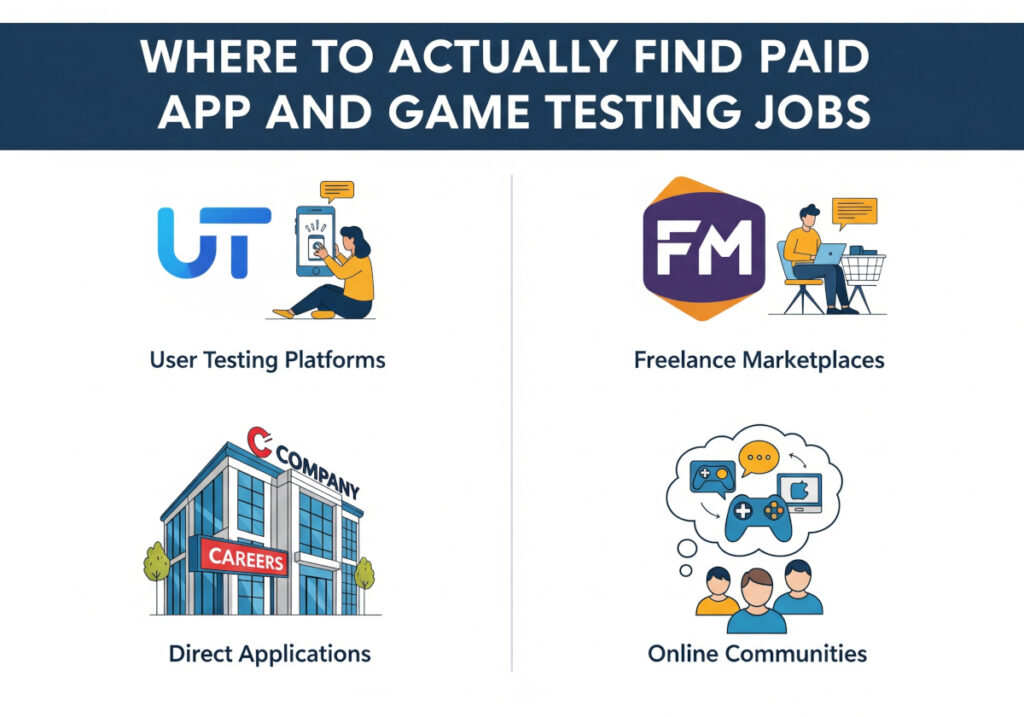
Let’s break it down into categories so you can choose the ones that fit your style and schedule.
10+ Dedicated User Testing Platforms
These are specialized sites where companies list opportunities for people to test apps, websites, or games before or after launch. The process is straightforward: you sign up, complete a profile (age, location, devices, and sometimes professional background), and wait for invitations that match your demographic and device setup.
The trick? The more complete and detailed your profile is, the more likely you are to qualify for tests. Also, keep multiple devices ready (desktop, laptop, smartphone, tablet) — this opens more opportunities.
1. UserTesting
UserTesting.com is arguably the most well-known platform in the industry. You’ll complete usability tasks while speaking your thoughts aloud so clients understand your decision-making process.
- Pay: About $10 for a 20-minute test; live interviews can pay $30–$60+.
- Pros: Consistent opportunities, good pay rates, professional clients.
- Cons: Highly competitive screeners — you won’t qualify for everything, so check often.
Install their Chrome extension and keep email notifications on. Tests disappear within minutes.
2. Userlytics
Userlytics offers a wide range of usability tests, including websites, apps, and prototypes. Some tasks are as short as 5 minutes, while others are more in-depth.
- Pay: $5–$20 depending on test length and complexity.
- Pros: Open to testers worldwide; flexible opportunities.
- Cons: Tests can come in bursts — you may have quiet days.
Keep your testing environment quiet. Poor audio can lead to rejection of your submission.
3. PlaytestCloud
PlaytestCloud is perfect for gamers. You’ll play unreleased mobile games and share feedback on gameplay, controls, and overall experience.
- Pay: Around $9 for a 15-minute session.
- Pros: Fun, beginner-friendly, no complex tech setup needed.
- Cons: Mobile-only; requires Android or iOS device that meets compatibility.
Be descriptive — game developers love hearing why you liked or disliked something, not just “It’s fun.”
4. Test IO
Test IO is geared more toward functional bug testing for apps and websites. Instead of just reviewing usability, you’ll actively hunt for bugs.
- Pay: Per bug found, with higher payouts for severe issues.
- Pros: High earnings possible for skilled testers.
- Cons: Requires attention to detail and some technical know-how.
Learn basic QA bug-reporting formats (steps to reproduce, screenshots, expected vs. actual results). This can make your reports more valuable.
5. BetaFamily
BetaFamily connects developers with beta testers for mobile apps. Payment varies widely, and sometimes the reward is early access or gift cards.
- Pay: Cash, gift cards, or free app subscriptions.
- Pros: Test interesting apps before public release.
- Cons: Payment is not always guaranteed or cash-based.
If you’re looking for paid gigs only, filter tests by reward type before applying.
6. Validately (Now part of UserZoom)
UserZoom Go (formerly Validately) focuses heavily on live moderated sessions. You’ll complete tasks while speaking with a researcher in real-time.
- Pay: $30–$60+ per live session.
- Pros: High pay for your time, professional feedback environment.
- Cons: Requires scheduling; you must be available at set times.
Treat it like a job interview — be professional, articulate, and punctual.
7. TryMyUI
TryMyUI.com offers usability testing for websites and apps, requiring you to record your screen and voice as you complete tasks.
- Pay: $10 for a 20-minute test.
- Pros: Quick payouts via PayPal; tests are straightforward.
- Cons: Tests are assigned based on demographic fit, so you might not get them daily.
Complete their qualification test thoroughly — this sets your quality score and impacts future invitations.
8. UserFeel
UserFeel.com is a multilingual usability testing platform, making it ideal if you speak more than one language.
- Pay: $10 per 10–20 minute test.
- Pros: Supports 40+ languages; easy to get started.
- Cons: Like others, test availability fluctuates.
Offer to test in multiple languages if you can — it increases your match rate.
9. Testbirds
Testbirds.com specializes in crowdtesting digital products, from mobile apps to smart devices. They offer both functional bug hunting and usability testing.
- Pay: From €20 per usability test; bug bounties vary.
- Pros: Wide variety of test types; supports testing on IoT devices.
- Cons: Some projects are for EU testers only.
Keep an updated list of all your devices in your profile — the more devices, the more projects you’ll see.
10. Enroll
EnrollApp.com provides quick, bite-sized usability tests that can be done from desktop or mobile.
- Pay: Varies by test (usually less than $1 for quick tests, but they’re extremely short).
- Pros: No microphone needed; easy to fit into spare moments.
- Cons: Lower pay compared to full-length usability studies.
Because they’re short, do them as soon as they pop up — they can be completed in under a minute.
11. PingPong
PingPong focuses on high-paying UX research interviews with global participants.
- Pay: €40–€100 per hour-long interview.
- Pros: Very high hourly rate; interesting, in-depth discussions.
- Cons: Requires scheduled participation and often professional background fit.
Fill in your profile with work history and hobbies — they recruit based on niche expertise.
12. Respondent
Respondent.io connects you with research studies for both consumer and professional audiences. Some are usability tests; others are market research calls.
- Pay: $20–$250+ depending on study length and target audience.
- Pros: Very high pay for specialized demographics; broad study types.
- Cons: Strict screening; must use LinkedIn for verification.
Apply even if you’re only 80% sure you match the screener — researchers sometimes approve near-fits.
Freelance Marketplaces
If you’d rather set your own rates and work directly with clients, platforms like Upwork and Fiverr allow you to list services such as “Mobile App Testing,” “Game Testing,” or “Website Usability Review.”
- Upside: You can land repeat clients who send you multiple projects.
- Downside: You must pitch yourself, maintain a strong profile, and handle client communication.
Include sample reports in your portfolio. Show clients exactly what they’ll get.
Direct Applications to Companies
Many game studios, tech startups, and software companies hire testers directly — often as Quality Assurance (QA) Testers or Beta Testers. These jobs may be part-time or full-time and can be more stable than gig-based platforms.
Where to look:
- Search for “QA Tester” or “Game Tester” on company career pages (e.g., Ubisoft Careers or EA Careers).
- Join beta programs directly from developers (e.g., Blizzard Beta Sign-Ups).
- Check indie game developer websites for open calls.
Online Communities and Forums
Sometimes the best opportunities don’t show up on mainstream job boards.
Places to check:
- Reddit: r/beermoney and r/GameTesting
- Discord: Join game development servers where devs post tester requests.
- Indie Game Forums: Many smaller dev teams post tester recruitment in forums before big releases.
Be quick. Beta testing spots (especially paid ones) fill up within hours. Set alerts and check communities daily.
5 Steps to Become a Successful Paid Tester & Get Paid
Knowing where to look is only half the battle. Here’s the process to get started and actually get accepted for paid testing work.
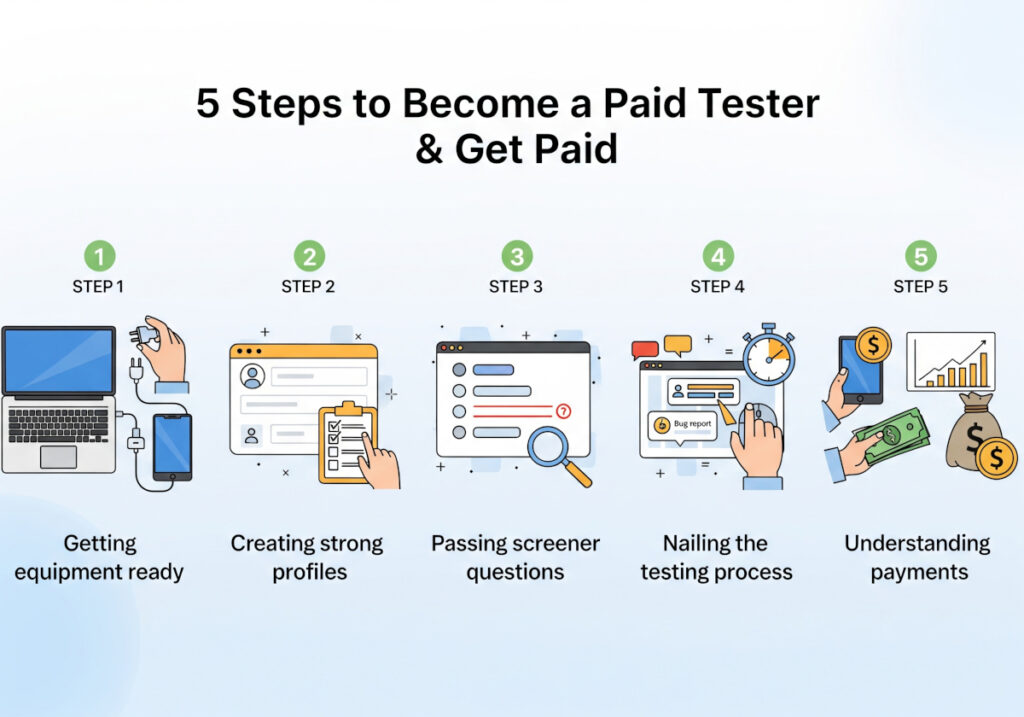
Step 1: Get Your Equipment Ready
You don’t need a high-end gaming rig to get started, but you do need the right basics:
- A reliable computer (PC or Mac)
- A smartphone and/or tablet (iOS and/or Android)
- A decent microphone (built-in can work, but external is better for live tests)
- Stable internet connection
- Quiet, distraction-free workspace
Step 2: Create Strong Profiles
Sign up for multiple platforms — don’t put all your eggs in one basket. When you fill out your profile:
- Be honest about your devices, internet speed, and demographic details.
- Add interests and experience that might make you relevant for niche tests (e.g., “VR gaming,” “finance apps,” “fitness tracking”).
- Complete any practice tests carefully; this is your first impression.
Step 3: Learn How to Pass Screener Questions
Screeners are short questionnaires platforms use to match you with the right projects. To improve your chances:
- Read the questions carefully before answering.
- Answer truthfully, but also highlight relevant experiences.
- Look for clues in the question that indicate the kind of tester they want.
Example: If the screener asks, “Have you used mobile banking apps in the past three months?” and you have, say yes — because they’re likely looking for users familiar with those apps.
Step 4: Nail the Testing Process
Once you’re in, you’ll need to deliver high-quality feedback.
- Follow Instructions Exactly — skipping steps can disqualify you.
- Think Aloud for usability tests so the client understands your thought process.
- Be Thorough — try different actions, explore menus, and test features fully.
- Give Actionable Feedback — instead of “This button is weird,” say “The ‘Next’ button is too close to the ‘Cancel’ button, which could cause accidental clicks.”
- Reproduce Bugs — if something breaks, explain exactly how to make it happen again.
Step 5: Understand How Payments Work
Most platforms pay through PayPal, sometimes gift cards, and occasionally direct deposit. Payment schedules can vary — some pay weekly, others monthly.
And yes, depending on where you live, you might need to declare this income for tax purposes. Keep a record of your payments and consult a tax professional if needed.
Tips for Making the Most Money as a Tester
You’ve got your profiles set up and you’re ready to start testing. But how do you go from occasional gigs to a steady, worthwhile stream of income? Here are proven strategies that experienced testers use.
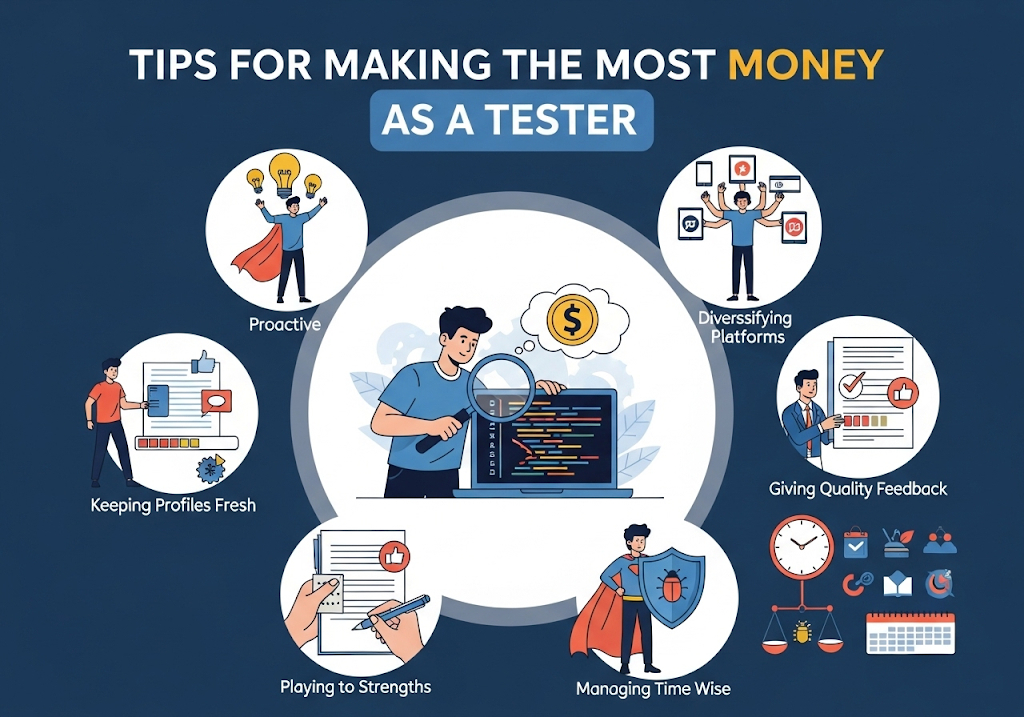
Be Proactive and Consistent
Opportunities come and go quickly. Many platforms post tests that fill up within minutes. Make it a habit to check your testing dashboards several times a day, and turn on email or app notifications where possible.
Diversify Your Platforms
Never rely on just one site. You might have a slow week on UserTesting but a busy week on PlaytestCloud. By spreading yourself across multiple platforms, you increase your odds of finding steady work.
Keep Your Profile Fresh
Update your device list and skills regularly. Bought a new iPhone? Added a VR headset to your gaming setup? That makes you eligible for more tests.
Some companies specifically look for niche experiences — such as owning a smartwatch or using certain apps — so adding those details can open new doors.
Focus on Quality Feedback
Platforms often rate testers, and high ratings lead to more invitations. Before you submit a test, review your recording or written feedback. Make sure you’ve:
- Spoken clearly and at a steady pace.
- Avoided long silences during think-aloud tasks.
- Explained why something didn’t work for you, not just that it didn’t.
Play to Your Strengths
If you’re great at spotting functional bugs, lean into platforms like Test IO that pay per bug.
If you’re good at verbalizing thoughts while using a product, focus more on usability testing with platforms like UserTesting and Validately.
Manage Your Time Wisely
While it’s tempting to take every test you see, rushing through them can hurt your ratings and lead to fewer invitations. Instead, aim for a balance between quantity and quality. Set aside a consistent block of time each day or week for testing.
Common Challenges and How to Overcome Them
Like any side hustle, app and game testing comes with its share of frustrations. Here’s what to expect — and how to deal with it.
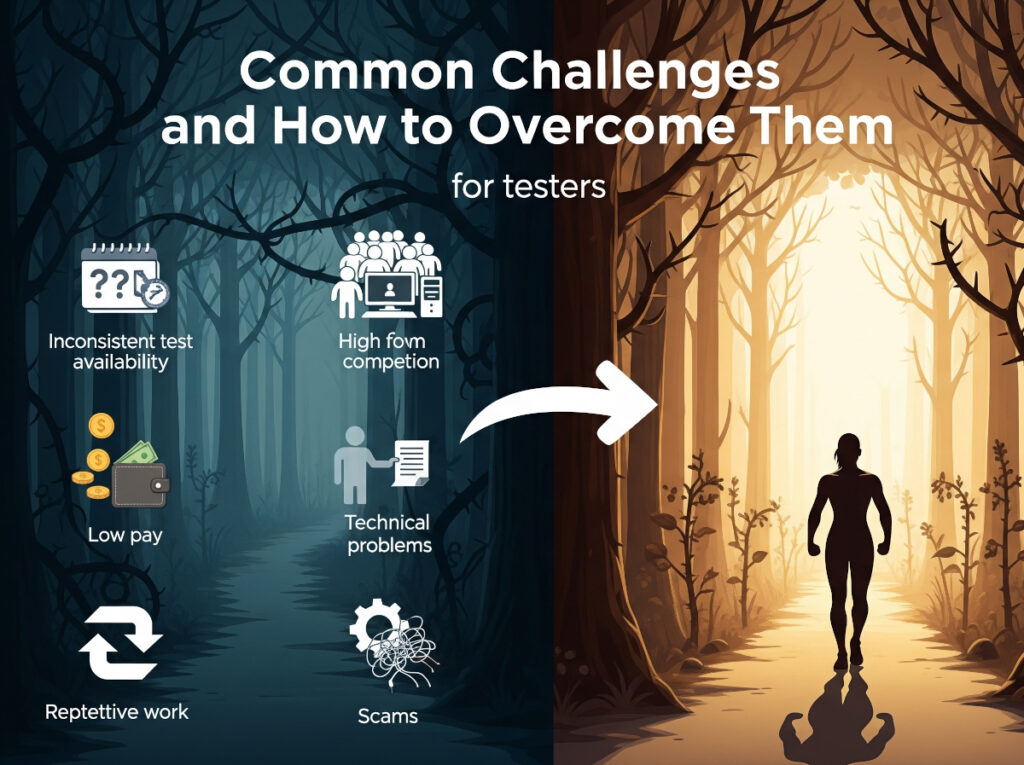
Inconsistent Test Availability
Some weeks you might get multiple invites; other weeks, none. That’s why it’s so important to sign up for multiple platforms and check them regularly.
High Competition for Screeners
If you find yourself constantly getting disqualified from tests, analyze your screener answers. Are you being too vague? Are you missing opportunities to showcase relevant experience?
Remember — some screeners are simply looking for a specific demographic, and it’s not personal if you don’t fit.
Low Pay on Some Platforms
Not every platform pays equally. Track your earnings per test and identify which sites give you the best return on your time. Focus your energy on those.
Scams and Fake “Testing” Jobs
Unfortunately, some people try to take advantage of the demand for testers. Watch out for:
- Jobs that ask you to pay a “membership fee.”
- Offers that promise huge earnings for almost no work.
- Poorly written job postings with no clear company name or contact info.
Stick to reputable platforms and companies, and when in doubt, research them before accepting a job.
Technical Issues
A test that crashes halfway through can be frustrating — especially if it’s not your fault. Always double-check your internet connection, keep your software updated, and have backup devices ready if possible.
Repetitive Work
Testing the same type of app or game repeatedly can get boring. Mix it up by joining platforms that offer different types of products — from finance apps to puzzle games to wearable tech.
Taking It Beyond a Side Hustle: Building a QA Career
While many people stick with casual, part-time testing, others turn it into a stepping stone for a full-time career in quality assurance.
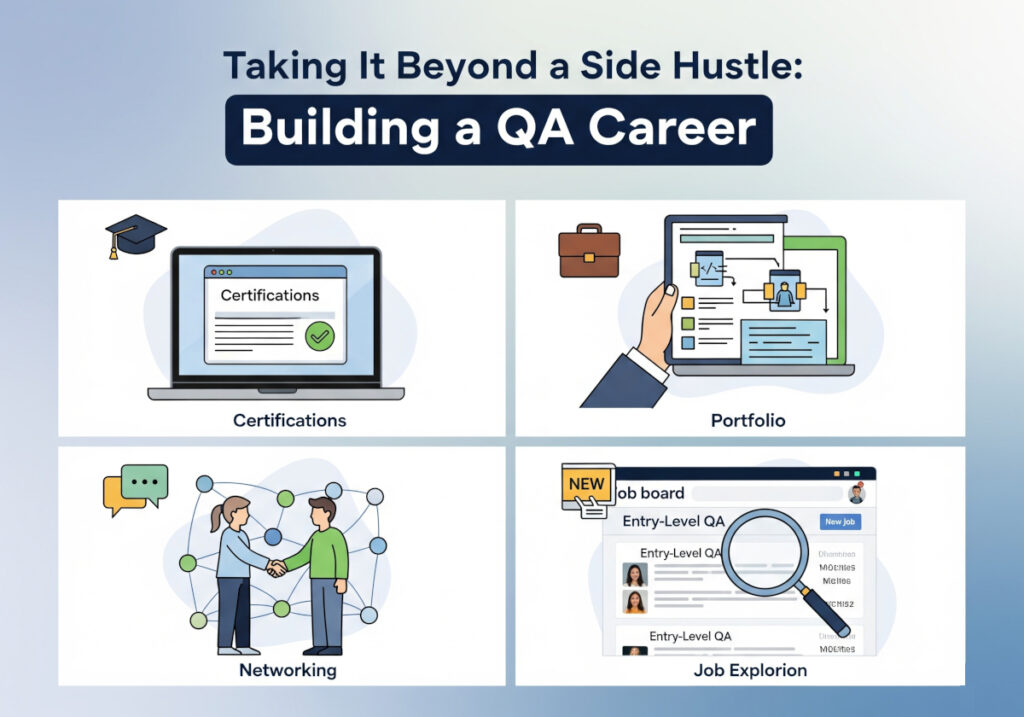
Consider Certifications
If you’re serious about going pro, look into the ISTQB certification or online QA courses from platforms like Coursera and Udemy. These can boost your credibility and open the door to higher-paying roles.
Build a Portfolio
Keep a record of your best bug reports, usability reviews, and client feedback. This portfolio can help you land freelance contracts or full-time QA positions.
Network with Industry Pros
Join LinkedIn groups, attend virtual game development meetups, and connect with other testers. Sometimes job opportunities come from word-of-mouth rather than job boards.
Explore Entry-Level QA Jobs
Many companies hire junior testers without years of experience, especially if you can demonstrate skill and reliability from your freelance work.
Conclusion
Testing apps and games for money isn’t just a fun way to explore new tech — it’s also a legitimate way to earn extra income from home. By combining attention to detail, clear communication, and a proactive approach to finding gigs, you can turn this side hustle into a steady stream of cash.
You don’t need to be a programmer, own a gaming studio, or have insider industry connections. All you need is a willingness to learn, follow instructions, and share your honest feedback.
So pick a couple of platforms from this guide, set up your profiles, and start applying. Your first paid test could be just a few clicks away.
Explore More
# Written by Elliyas Ahmed





